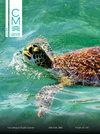粘细胞丛:20种梳状水母(栉孔门)成胶细胞的比较形态计量学分析
IF 0.7
4区 生物学
Q4 MARINE & FRESHWATER BIOLOGY
引用次数: 1
摘要
触手纲的Ctenophores与刺动物的不同之处在于,它们使用粘性而非刺性的触手来捕捉和制服猎物。使这些触手具有粘性的结构是成胶细胞,这是一种专门用于捕食的多细胞粘性结构。成胶细胞位于触手、触手侧支(壶突)或口腔壶突上,仅在梳状水母(栉孔门)中发现。为了对栉水母成胶细胞的多样性进行比较解剖,使用蓝水潜水员和遥控潜水器从加利福尼亚州中部和夏威夷群岛海岸附近的上半深海区采集了标本。触手样品立即在海上固定在4%福尔马林溶液中,然后在实验室中通过在2%OsO4中的二次固定制备,用于扫描电子显微镜(SEM)。用扫描电镜观察了超微结构特征的多样性,记录了9科9属20种植物的胶体、外泌颗粒和螺旋丝的形态计量学,其中13种未描述。成胶细胞的形态测定表明,胶球(粘性颗粒的组织单位)的形状可分为3类:球形、椭球形或非均匀形。外部分泌物颗粒沉积可分为两类:聚集型或模式型;帽细胞膜存在或不存在。这一形态变化以图表形式总结,将有助于描述有趣和有争议的栉孔门的功能多样性和觅食生态学。本文章由计算机程序翻译,如有差异,请以英文原文为准。
A sticky thicket of glue cells: A comparative morphometric analysis of colloblasts in 20 species of comb jelly (phylum Ctenophora)
Ctenophores in the class Tentaculata are distinct from Cnidarians in that they use sticky, not stinging, tentacles to capture and subdue their prey. The structures that make these tentacles sticky are colloblasts, specialized multicellular adhesive structures for predation. Located on the tentacles, tentacle side-branches (tentilla), or oral tentilla, colloblasts are only found in comb jellies (phylum Ctenophora). To perform comparative anatomy of the diversity of ctenophore colloblasts, specimens were collected from the epito bathypelagic zones near the coasts of central California and the Hawaiian Islands using blue-water divers and remotely operated vehicles. Tentacle samples were immediately fixed in a 4% formalin solution at sea, and then prepared in the lab via secondary fixation in 2% OsO4 for scanning electron microscopy (SEM). Diversity of ultrastructural characteristics was observed using SEM, and the morphometrics of the collosphere, external secretion granules, and spiral filament were recorded for 20 species, within 9 families and 9 genera, including 13 undescribed species. Morphometry of colloblasts reveals that the shape of the collosphere (the organizational unit of sticky granules) falls into 3 classifications: spherical, ellipsoidal, or non-uniform. External secretion granule deposition falls into 2 categories: clustered or patterned; the cap cell membrane was either present or absent. This morphological variation is summarized graphically and will be useful to describe the functional diversity and feeding ecology of the interesting and controversial phylum Ctenophora.
求助全文
通过发布文献求助,成功后即可免费获取论文全文。
去求助
来源期刊

Ciencias Marinas
生物-海洋与淡水生物学
CiteScore
1.10
自引率
0.00%
发文量
9
审稿时长
>12 weeks
期刊介绍:
A bilingual open-access publication, Ciencias Marinas (CM) is an international peer-reviewed journal that contains original research findings in all areas of marine science. It is published quarterly by the Autonomous University of Baja California, Mexico, and all its contents are publicly available on our journal website. Though a limited number of copies are still printed, the journal is mainly distributed in its electronic format.
CM was conceived in 1973 as part of an academic project aimed to entice local researchers to publicly disclose their findings by adopting the culture of peer-review publishing. This academic project evolved into an international journal after accepting papers from researchers in the United States and, eventually, other parts of the world. Because of the diversity in authorship, CM issues were initially published in either Spanish or English, and occasionally in both languages. It was not until 1984 when CM included both language versions of all its contents, and it then became the fully bilingual journal it still is today. At CM we believe our inclusive format allows us not only to address a wider range of submissions from international authors but also to make published findings available to a wider international audience.
So whether you are looking for information on the redfish in Icelandic waters or the physical and biological properties of the Gulf of California, feel free to peruse CM contents. You may find them to provide source material for your research.
 求助内容:
求助内容: 应助结果提醒方式:
应助结果提醒方式:


